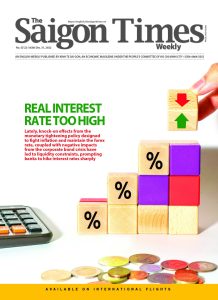With banks joining an interest rate hiking race that may lead to economic uncertainties, it is high time to take measures to stabilize this vital macroeconomic issue.
A non-beneficial race
After the State Bank of Vietnam (SBV) lowered its policy rates twice in September and October, while the recapitalization rate and overnight rate on the interbank market returned to the pre-pandemic levels (prior to March 17, 2022), at 6% and 7%, respectively, the ceiling deposit rate for tenors of shorter than six months has surged.
To cope with the pandemic-induced depression, the SBV cut the deposit rate for tenors shorter than six months three times in 2020. Specifically, the central bank lowered the deposit rate by 0.25 percentage point on March 17, 2020, by 0.5 point on May 13, and another 0.25 point on September 20. However, the SBV raised the deposit rate by 1 percentage point in each of the two latest adjustments, taking the ceiling rate one point higher than the pre-pandemic level.
The rate rose stronger for deposits longer than six months, as the interest rates for such tenors are not capped under any regulation. The race to hike interest rates shows the liquidity pressure and the huge demand for capital facing banks. According to the Vietnam Banks Association (VNBA), the borrowing rate at banks compared to the end of 2021 have increased by 3-4 percentage points for deposits longer than six months. Compared to the average deposit rate in February 2020 before the SBV lowered its policy rates, the borrowing rate for deposits of one to five months is nearly 2.3 percentage points higher, meaning more banks have offered deposit rates near the ceiling. Currently, the average interest rate for deposits of six to 11 months is 2.8 points higher year on year, while deposit rates for terms of 12 months or longer are 2.6 points higher.
In fact, prior to the pandemic outbreak, the maximum deposit rate for tenors of 12-13 months was offered by banks at 8%, but it has now climbed to 10%, or even 11-12% at certain banks.
The above comparisons show how interest rates have surged rapidly lately. Riskier still, certain banks have taken unfair practices in the race, wooing clients by verbally informing to add some percentage points as a bonus to long-tenor deposit rates.
Reasons behind the rate hike, apart from the effect of monetary tightening, include moves by small- and medium-sized banks to raise rates higher than the market average to retain clients as the people’s confidence in small lenders has been eroded following negative developments at Saigon Commercial Bank lately. Consequently, money has shifted from banks with lower deposit rates to those offering higher rates, forcing the former to hike rates as well. The cycle repeatedly goes on, lifting the average deposit rate higher, especially at a time when access to interbank capital proves more difficult, which also comes with a higher rate as well.
No matter what reason it might be, the interest rate competition has escalated, not only causing difficulties for banks but also damaging the economy and impeding the growth of businesses, resulting in macroeconomic uncertainties, risks of rising bad debt, and possibly a recession as warned by analysts.
Harnessing interest rates
Given this dilemma, the need to harness and stonewall the rapid rise of interest rates must be more attended to, and it should be a focal target for the economy in the rest of this year as well as next year. VNBA has recently convened a meeting, and its members have agreed to join forces in lowering interest rates.

Specifically, all VNBA members approved two key issues at the meeting. First, they agreed to cap the deposit rate at 9.5% a year, inclusive of bonus. Such a cap will douse the race among banks to hike interest rates. Second, they agreed to lower lending rates by 0.5-2.0 percentage points depending on the financial capacity of banks and their ability to cut costs. Further, some bankers pledged to provide sufficient capital for eligible businesses and individuals.
In fact, several banks have lately hinted at lowering lending rates to support their clients. For example, OCB has launched a credit line of VND3,000 billion for enterprises trading in essential commodities, with a preferential rate of 8% a year. VPBank has also announced to cut the lending rate by 1.5 points for small- and medium-sized enterprises, applicable to short-term loans as well. However, it seems the recent moves by banks to lower the lending rate are aimed at convincing the SBV to ease the credit growth cap for such banks this year and next.
If the past is any indication, banks have several times reached consensus on stabilizing interest rates, but reality showed maintaining such consensus is a tough challenge, not only because of unpredictable macroeconomic changes, but also due to the varying capital strengths and liquidity pressures at different banks, while access to interbank capital sources also changes from time to time.
However, as constraints on the foreign exchange market and the forex rate have been eased and inflation is well controlled, coupled with improved liquidity at banks due to the higher deposit volume from the people, it is expected the consensus this time will be respected, especially after the SBV has lately pledged to supply enough capital to the banking industry. Any bank mired in a liquidity crunch can seek the SBV’s support in terms of lending via open market operations, foreign currency swap, and recapitalization.
Specifically, at a conference to discuss measures to support enterprises in production and business on December 15, 2022, deputy governor of the SBV Dao Minh Tu said the central bank on the day had issued an instruction requiring banks to lower both borrowing and lending rates to support enterprises and the economy. “This is an instruction, not a call. The Prime Minister and the SBV have ordered that banks cut costs to reduce interest rates to support enterprises. Any banks finding it hard to do so need to make reports to the SBVso that we can work it out,” said the deputy governor.
Many bankers at the conference proposed the SBV help improve liquidity for the system by making loans via open market operations on mortgaged valuable papers, foreign currency swap, and recapitalization. Banks also proposed that the SBV ease conditions on the loan to deposit ratio in the context of difficult mobilization.











